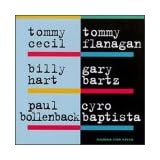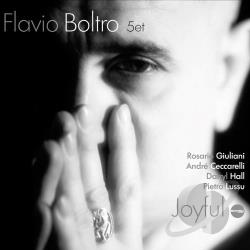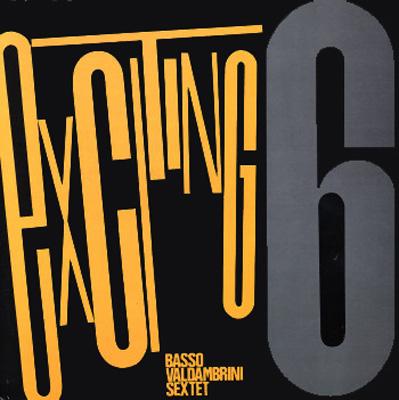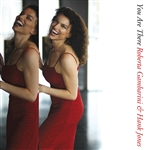As should be clear from previous posts, there is a coterie of Italian jazz musicians that not only lead their own bands but also work collectively together in a variety of places and settings. Pieranunzi, Basso, and Sellani are three of the grand masters, and each not only has played music with many others but each has also mentored the next generation.
This post brings to the fore one of the younger, but no less talented, pianists, Danilo Rea, whose name has already come up in conjunction with the CDs of the masters. Rea is a comparative youngster, born in Vincenza in 1957, educated at the Santa Cecilia Music Conservatory in Rome, debuting on record for the first time in 1975 with the Rome Trio of Roberto Gatto and Enzo Pietropaoli (two names for a later post)and debuting as a leader on record only in 2003. Since then, AllMusic lists him as leader on about a dozen CDs, as well as a supporting member of countless others. He is also a member of a wonderfully inventive trio, Doctors 3, which I will include in this post as well.

During his career, he has worked with Chet Baker, Lee Konitz, Phil Woods, Art Framer, Curtis Fuller and Kenny Wheeler among international stars. Running further down the list is like looking at the "Who's Who" of Italian Jazz: Paolo Fresu, Renato Sellani, Franco D'Andrea, Roberto Gatto, Enzo Petropaoli, Flavio Boltro, Aldo Romano, Giovanni Tomasso, and Pietro Tonolo are sprinkled throughout his discography. Finally, he is also sought after as a player of Italian pop music, and has played behind many Italian pop singers. His work with the piano trio
Doctors 3 highlights that aspect of his play very well.
Rea is a player who is capable of performing across the broadest of musical categories, from classical music to jazz and pop music. As a young disciple of the masters and child of the 60s and 70s, Rea's influences extend across a wider range of music than Sellani and even Pieranunzi, although the latter certainly shows the same sparks of modernism and boldness at times that characterizes Rea's work. Rea is certainly more into the modern songbook, but still retains the same attention to melody and the harmonic sensibilities of his masters, never straying too far out of the box. His discography highlights the variety in his work, both in terms of his musical breadth as well as the settings -- solos, duos, trios, and a quintet are all a part of the collection I have of his music. These performances are done both in studio and live from the Umbria Jazz Festival, where Rea has bcome one of the featured performers in each format and with Doctors 3.
His CDs as leader demonstrate that Rea has a number of personalities that he brings to the music.

"Lost in Europe" (Via Veneto Jazz 2000) has one of my favorite whimsical covers, and documents music from a solo piano tour of Europe in the summer of that year. The range of the music is broad and the perfomrances are full of life, expression, and wit. Two pieces were penned by Rea, and several of the pieces are actually mini-suites. To understand the variety in Rea's repetoire, take the seventh piece on the disc, an amalgam of one show tune, "America", one classical piece, "Pour le Piano" by Debussy, one song by Rea, and one Italian song "Un Gioro Dopo L'Altro," and watch them unfold seamlessly and effortlessly. "Tico Tico" is magnificently expressive, rapidly paced, with a hidden surprise; "Sospensione so expresssive and with an ending so passionate it could make you cry. Another suite links the following -- "What a Wonderful World", Time After Time", "La Danza", and "Mr. P.C." The music is incredible, the imagination tremendous, and the playing bold.
"Improvvisi" (Duck Record 2002) is a duo recording with drummer Robert Gatto, a major name in Italy as well. My Italian is not so good, but the liner notes basically say that in the past year the two friends decided upon a collaboration, and to do an ambitious program -- eliminating any pre-ordained playlist and in fact no songs at all unless they came to them spontaneously. They would create from the air the melodies, rhythms, and harmonies. They would be guided by their backgrounds, culture, and communal language. They would let the sounds guide them, and when they were done, they hoped to have a recording worth hearing. And they succeeded and the results speak for themselves, 13 pieces, 11 originals and two others, of varying tempos -- with a common bond of two players who clearly are in touch with each other. Jazz and classical music merges here in the originals, one of which is dedicated to Debussy, and in a lovely rendition of the Moldau by Smetana. Brilliant showmanship.
"Romantica" (Venus Records 2004) is a piano trio, with Ares Tavolazzi on bass and Gatto again on drums. My Italian might be bad, but I cannot read Japanese at all, so the liner notes are useless. But the music is magnifico -- here we have jazz interpretations of what I believe are Italian favorites, of whom I only recognize Ennio Morricone's name. What I do know is that the melodies are all as romantic as advertised in the title, Rea brings to each his full bag of expressive chords, runs, and range of dynamics. Gatto keeps the tempo, adds color, and introduces several of the tunes with the snare and cymbals, that then underlie the melodies. On "Munastero 'E Santa Clara" plays a bongo-like rhythm that adds sparkle to the tune, the second on the disc, and on Tu Si' Na Cosa Grande he maintains a latin beat for Rea's lilting tune. These sound like the "Great Italian Songbook" as sung by Sergio Franchi, Mario Lanza, and others.
 "Piano Works X, Danilo Rea at Schloss Elmau: A Tribute to Fabrizio De Andre"
"Piano Works X, Danilo Rea at Schloss Elmau: A Tribute to Fabrizio De Andre" (ACT 2010) is a solo recording in a settting that has seen a number of solo piano artists come before. Fabrizio De Andre was an Italian singer-songwriter who died prematurely in 1999, well-known in his homeland for his challenging songs and their subjects, often those who were most in need of aid. Rea has taken this powerful body of work and to it has applied his ample creative powers, as the notes say to create "...classical stud[ies] to chromatically dazzling ballads and from swinging syncopated blues to free jazz impressions." The music overflows with Rea's brilliance, expressive play, and melodic sensibilities once again. Easy to find and well-worth the effort to do so.

Rea returned to Schloss Elmau in 2011 with the trumpet player Flavio Boltro (see yesterday's post on Boltro) for "Opera". In such a brilliant accoustical setting, the sounds from Boltro's trumpet and Rea's Steinway are bell-like, clear and beautifully balanced, as the two cover 12 pieces of Monteverdi, Rossini, Bellini, Giordani, Vivaldi, Puccini, and Cilea, in their own very creative and clearly jazz-tinged way. The passions of the two classically trained players were made for this music, and the drama of the opera is transmuted to their golden sounds and to the improvisations. High drama, big emotions, all of the best characteristics of the opera are here, with a jazz twist, and played through a great range of dynamics to tell their stories. The piece most of us are most familiar with, the "William Tell Overture" concludes the CD and the twists are most evident to the non-opera listener, and very enjoyable as well. It is nothing you have ever heard --some blues, some boogie woogie -- I am sure many opera lovers would have their ears covered early and often. But not the jazz fans.
As I said before, Rea is loved throughout Italy and particularly at the Umbria Jazz Festivals each Jazz Italiano Live used to put out annual recordings from the festival of its major stars, and I have those from 2006 and 2009 by Rea: "Jazz Italiano Live 2006: Danilo Rea" "Jazz Italiano Live 2009: Danilo Rea" (Azienda Speciale Palaexpo 2006 and 2009). The 2006 disc is a quintet with Marcello Sirignano on violin, Pietro Tonolo on saxes, Giovanni Tommaso on bass, and Massimo Manzi on drums. It is 14 pieces all written by Rea and played nicely by the group, with the crowd clearly enjoying the music, the plyaers, and the energy that readiates from all of it. In 2009, REa played with a trio, inclduing Enzo Pietropaoli on bass and Roberto Gatto on drums, an 11 piece outing that again features all original songs and the ususal high standards expected of the three players.
So who is Danilo Rea? He is a perfomer of astonishing solo concerts based on opera, an improvisor who does concerts in the manner of Keith Jarrett, a lover of the great standards from his country and the U.S., and a nodernist who enjoys the pop music of the 60s, 70s and later. He is bold ands creative, expressive and romantic, and a composer of beautiful tunes. He is lively on stage and in performance on disc, humerous in his choices, and a true entertainer, not unlike another pianist from Italy, Stefano Bollani (who will have his day here as well).
And now onto Rea's other musical identity, that of the pianist in Doctor 3, a trio with Enzo Pietropaoli on bass and Fabrizio Sferra on drums. This is one heck of a fun group, seemingly dedicated to having fun playing largely the music of their youth and mine from the 60s and 70s, interspersed here and there with the Great American Songbook. The music is simply fun and the group projects that in the studio and particularly in live performances at the Umbria Jazz Festivals. Each player is a master of his instrument, and of the repetoire, so the musical expression comes easily and creatively from each. They seem to have 6 CDs in print, of which I have four, as follows:

In 1999, the first one I have is
"The Songs Remain the Same" (Via Veneto Jazz 1999), clearly a reference to Led Zeppelin, and the songs are a mix of pop/rock, standards, and traditional music. Six of the 11 pieces are composites of multiple songs, and the first starts the listener off in a traditional vein, with "Danny Boy" and "Bye Bye Blackbird." From there we have mixes like "A Salty Dog" with Charlie Parker's "Buzzy", "Stairway to Heaven" with "Cam Camini", and "Stella By Starlight" with two lovely melodies by the group and by Domenico Modugno. If this sounds a bit weird it is not; in fact the blends are done seamlessly, and the jazz improvistations polish each piece to a gem-like appeal. U2, Emerson Lake and Palmer, and Peter Gabriel all make an appearance as well on this wonderful set.

In 1999 the group referenced Led Zeppelin in the title; in 2001 they reference themselves. The disc is
"Bambini Forever" (Via Veneto Jazz 2001) and expresses wonderfully the child-like fun the group has when they mash the music together. Ten sets this time with only two Lennon and McCartney songs -- "Here There and Everywhere" and "She's Leaving Home" -- not being mash-ups. The rest are three or four song suites, and the range of composers include the Red Hot Chili Peppers, Wayne Shorter, Hammerstein and Kern, Pat Metheny, and Sting; along with several group originals and a set dedicated to Fabrizio De Andre. This is another hit that demonstrates that the jazz songbook can be open to much more than the Great American Standards, and demonstrates exactly how three creative musicians can turn rock into real, believable and enjoyable jazz.
For
"Jazz Italiano Live 2007: Doctor 3" (Azienda Speciale Palaexpo 2007) the group dedicated itself to two composers in a single, unified set of 13 memorable songs that almost everyone knows. The composers are Lennon and McCartney, and the set is a jazz version of
"Sargent Pepper's Lonely Hearts Club Band." Jazz traditionalists and purists might scoff at the set, but there is nothing but imagination (no pun intended), free play, and joy in the set. Clearly the trio is enjoying themselves, and the feeling transmits itself to the live audience and over the speakers to those of us hearing it on disc. This is a toe-tapping tour de force for the trio.
In 2008, the trio came back to Umbria once more, and almost one-upped its last performance, on "
"Jazz Italiano Live 2008: Doctor 3"(Azienda Speciale Palaexpo 2008), with several more rock hits in a jazz mood, with a few other songs from De Andre and others as well. This time the set varied among the rock composers -- Fred Neil's "Everybody's Talkin' At Me", Ragni and Rado"s "Aquarius/Let the Sunshine In" from Hair, Jagger and Richards' "Jumpin' Jack Flash", Paul Simon's "Sound of Silence" and "Mrs. Robinson -- included some pop by Bert Bacharach and Hal David "This Guy's in Love With You" and some soul by Otis Redding ("Sittin' on the Dock of the Bay"). But my personal favorite is the traditional "John Barleycorn Must Die" (done by Traffic) with "Steve Winwood's "Glad".

Doctors 3 must have been created to bring a smile to everyone's faces, and does everytime out. Rea's humor, shown periodically in his works as a leader outside the group, blossoms with this group, and a good time is had by all.
So that is Danilo Rea -- creative, expressive, and a master of many genres. His music is the equal of any pianist playing today, so pick one of his CDs up soon and give him a chance.
NOTE: This was post 100 on this blog. I wan't sure when I started I could get his far or had enough to say, but it turns out I have been enjoying the opportunity to write about something I truly love. I hope that those who are reading this feel the same about jazz, and maybe even about the blog. Thanks to all of you.
 In the case of Abou-Khalil it is his debut recording, "Al-Jadida" (Enja 1991). For Brahem, it is Jan Gabarek's "Madar" (ECM 1994). Both demonstrate beautifully the potential of the oud, tabla and other eastern instruments in jazz; both include the saxophone as an instrument that creates the link to jazz, with Gabarek the leader on his own recording, and Sonny Fortune on the Abou-Khalil disc.
In the case of Abou-Khalil it is his debut recording, "Al-Jadida" (Enja 1991). For Brahem, it is Jan Gabarek's "Madar" (ECM 1994). Both demonstrate beautifully the potential of the oud, tabla and other eastern instruments in jazz; both include the saxophone as an instrument that creates the link to jazz, with Gabarek the leader on his own recording, and Sonny Fortune on the Abou-Khalil disc.  I happen love the sound of the oud, and the introduction of it into the jazz genre. I am not really sure I can express why I feel this way, but I can try. And I can also refer you to the August 2012 issue of Jazz Times, which has a lengthy article about the oud and oud players.
I happen love the sound of the oud, and the introduction of it into the jazz genre. I am not really sure I can express why I feel this way, but I can try. And I can also refer you to the August 2012 issue of Jazz Times, which has a lengthy article about the oud and oud players.  Abou-Khalil has gone on to great success, with numerous recordings on Enja, and has constantly changed his instrumentation to reflect his intrests, growth and experimentation with sound. I particularly am drawn to two recordings on which Kenny Wheeler plays a major role, "Blue Camel" (Enja 1992) and "Sultan's Picnic" (Enja 1994). Blue Camel in particular is cited as one of Abou-Khalil's masterpieces, with a mood characteristic of "Kind of Blue" according to AllMusic.com. It includes Wheeler, saxophonist Charlie Mariano, and bassist Steve Swallow from the western tradition, along with a number of eastern players on a range of percussion instruments. The fusion of east and west is extraordinary, and the melodies and harmonies mix both effectively to create an enchanting, seductive piece of music. "Sultan's Picnic" also has Wheeler and Mariano, but introduces a harmonica to the mix, in the person of Howard Levy, to further experiment with sound.
Abou-Khalil has gone on to great success, with numerous recordings on Enja, and has constantly changed his instrumentation to reflect his intrests, growth and experimentation with sound. I particularly am drawn to two recordings on which Kenny Wheeler plays a major role, "Blue Camel" (Enja 1992) and "Sultan's Picnic" (Enja 1994). Blue Camel in particular is cited as one of Abou-Khalil's masterpieces, with a mood characteristic of "Kind of Blue" according to AllMusic.com. It includes Wheeler, saxophonist Charlie Mariano, and bassist Steve Swallow from the western tradition, along with a number of eastern players on a range of percussion instruments. The fusion of east and west is extraordinary, and the melodies and harmonies mix both effectively to create an enchanting, seductive piece of music. "Sultan's Picnic" also has Wheeler and Mariano, but introduces a harmonica to the mix, in the person of Howard Levy, to further experiment with sound.  Brahem has gone on to a long and beautiful relationship with ECM, producing eight other recordings as a leader. "Madar" was his second recording. Brahem's second album as leader, "Conte De L'incroyable Amour" ( ECM 1992) was recorded with clarinet player Barbaros Erkose, and its melodies are equally distinctive and haunting. On "Le Pas du Chat Noir" (ECM 2001) and the following "Le Voyage de Sahar" (ECM 2006) Brahem reaches what for me is his pinnacle, as he merges his sound with those of Francois Couturier on piano and Jean-Louis Matinier on accordion. Without the tabla or other percussive instruments besides the piano, the sound is far more delicate. The songs are more peaceful, and the pairing with the piano and accordion suits his style as the three draw notes and ideas draw out on wonderful pieces throughout. The interplay is lovely and thoughtful, with a lot of trading and listening to each other to provide pieces of subtlety and beauty. Brahem is wonderfully subdued as are the two others, as Couturier had demonstrated on his own ECM outings. Thesse are intensely quiet outings that improve with each listen as the flows become clearer and the subtle compings of one or another support the melodies.
Brahem has gone on to a long and beautiful relationship with ECM, producing eight other recordings as a leader. "Madar" was his second recording. Brahem's second album as leader, "Conte De L'incroyable Amour" ( ECM 1992) was recorded with clarinet player Barbaros Erkose, and its melodies are equally distinctive and haunting. On "Le Pas du Chat Noir" (ECM 2001) and the following "Le Voyage de Sahar" (ECM 2006) Brahem reaches what for me is his pinnacle, as he merges his sound with those of Francois Couturier on piano and Jean-Louis Matinier on accordion. Without the tabla or other percussive instruments besides the piano, the sound is far more delicate. The songs are more peaceful, and the pairing with the piano and accordion suits his style as the three draw notes and ideas draw out on wonderful pieces throughout. The interplay is lovely and thoughtful, with a lot of trading and listening to each other to provide pieces of subtlety and beauty. Brahem is wonderfully subdued as are the two others, as Couturier had demonstrated on his own ECM outings. Thesse are intensely quiet outings that improve with each listen as the flows become clearer and the subtle compings of one or another support the melodies. 














 Renato Sellani was born in the province of Ancona on the west coast of Italy in 1926, and is another master of the jazz piano; in fact, he is often referred to as "Il Maestro." He came to jazz late, after studying political science at the University in Rome. It was during this time that he got hooked on jazz, spending a lot of his time in the nightclubs of the capital, and then teaching himself to play the piano at the home of a friend. This was during the period right after World War II when Italy was returning to normalcy after the Fascist era, and the nightlife was grand. Sellani evidently was a natural at the piano, since by 1958 he was invited to Milan by his friend and fellow musician Franco Cerri, widely considered the best guitarist ever produced by that country. Milan was a center of the arts and a major stopping point for American jazz players at that time, and Sellani prospered by being among them. He joined the quintet Basso and Valdambrini, and played in that group for quite a long time, although he also became well known as a solo artist as well. Sellani must have been already recognized as a star, for he met and played with the singer Billie Holiday early on, and then was clearly good enough to be Chet Baker's first pianist in Italy, and later an accompanist for Sarah and Sarah Vaughan and Helen Merrill. The pairing produced at least one classic album, "Chet Baker in Milan" (Jazzland/OJC 1959) which is easily recommended and they also toured together
Renato Sellani was born in the province of Ancona on the west coast of Italy in 1926, and is another master of the jazz piano; in fact, he is often referred to as "Il Maestro." He came to jazz late, after studying political science at the University in Rome. It was during this time that he got hooked on jazz, spending a lot of his time in the nightclubs of the capital, and then teaching himself to play the piano at the home of a friend. This was during the period right after World War II when Italy was returning to normalcy after the Fascist era, and the nightlife was grand. Sellani evidently was a natural at the piano, since by 1958 he was invited to Milan by his friend and fellow musician Franco Cerri, widely considered the best guitarist ever produced by that country. Milan was a center of the arts and a major stopping point for American jazz players at that time, and Sellani prospered by being among them. He joined the quintet Basso and Valdambrini, and played in that group for quite a long time, although he also became well known as a solo artist as well. Sellani must have been already recognized as a star, for he met and played with the singer Billie Holiday early on, and then was clearly good enough to be Chet Baker's first pianist in Italy, and later an accompanist for Sarah and Sarah Vaughan and Helen Merrill. The pairing produced at least one classic album, "Chet Baker in Milan" (Jazzland/OJC 1959) which is easily recommended and they also toured together













